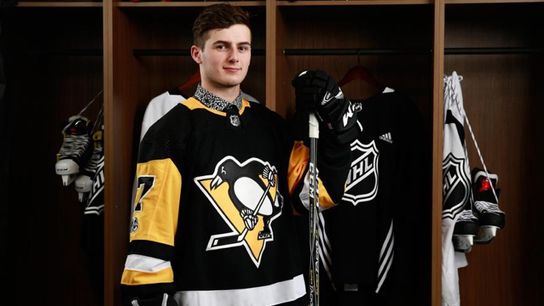Exactly who the Penguins will take with the 53rd overall pick in next weekend's NHL Draft is a mystery to everyone, Jim Rutherford included.
The names of Rasmus Dahlin, Brady Tkachuk, Andrei Svechnikov and a few other top prospects will be long off the board by the time the Penguins select Saturday morning. But those are the kinds of contingencies that the general manager says he and his staff are well prepared for. In fact, they've kind of gotten used to it.
The Penguins haven't selected on the first day of the draft since 2014, when they picked Kasperi Kapanen. Instead, they've dealt their first-round picks for NHL-ready assets each of the last four years. It's simply been the price of doing business while winning the Stanley Cup (2016 and '17) or contending for it ('18).
This year's first-rounder (22nd overall) was dealt to Ottawa in part of the three-team Feb. 23 trade that landed Derick Brassard. The 2017 pick (31st overall) was dealt to St. Louis for Ryan Reaves. The 2016 pick (30th overall) was dealt to Toronto as part of the Phil Kessel trade. The 2015 pick (16th overall) was dealt to Edmonton for David Perron.
The question is whether this strategy of dealing top picks is sustainable?
The short answer is, yes, as long as the Penguins are still Cup contenders. But at some point the organization is going to have to start investing in its future when the primes of Sidney Crosby, Evgeni Malkin, et al, come to their conclusion. Obviously, the Penguins are hoping that's not any time soon.
The success of the organization has always lay in securing generational talents like Mario Lemieux, Jaromir Jagr, Crosby and Malkin. All were top five picks and Lemieux and Crosby -- the two greatest players in franchise history -- went first overall. Only two teams in the last 47 years, the 1989 Flames and 2001 Avalanche, lifted the Cup without one player drafted in the top three on the roster.
Could the Penguins trade up to get into the first round to get a Tkachuk or Svechnikov or Filip Zadina or Quinn Hughes or another of the other top prospects? Don't count on it.
"I doubt it at this time," Rutherford told DKPittsburghSports.com. "It's not a possibility. It's a pretty heavy price to move up. If you can move up into the top five, that's when you're willing to pay a high price. But just to get into the first round, the last part of the first round? I don't believe it's worth paying the price at this time."
Over the past four years the average draft position of the Penguins' first selection has been 50th overall, or in the middle of the second round. Whoever the Penguins take at No. 53, Rutherford believes he can still get a first-round talent.
"The guy that we'll pick at 53 on our list will probably be rated in the first round," Rutherford said. "But everyone's list is different. Doesn't mean it's right, doesn't mean it's wrong. But it'll certainly be a guy we have rated in our top 30 and our scouting staff will feel good about him when we get to that point."
That was certainly the case last year when the Penguins selected Zachary Lauzon, a defenseman for Rouyn-Noranda of the QMJHL. Some thought they reached to take Lauzon, who had been ranked as the 143rd North American skater by NHL Central Scouting. Obviously, the Penguins felt a little bit stronger about him, taking him 51st overall.
Though Lauzon remains a project, the Penguins' track record in the second round under Rutherford is quite good.
In 2016, they selected Swedish goalie Filip Gustavsson with the 55th overall pick. Gustavsson posted a 1.81 goals-against average and .924 save percentage at last year's World Junior Championship, leading Sweden to the silver medal and being named the tournament's most outstanding goaltender. With a glut of goaltenders, including 2012 third-rounder Matt Murray and 2013 second-rounder Tristan Jarry, the Penguins were able to deal Gustavsson to the Senators in the Brassard trade.
The year before that, they picked Daniel Sprong, a Dutch-born winger from Charlottetown of the QMJHL with the 46th overall pick. He had been the 20th-ranked North American skater. Sprong, you may have heard, is the top prospect in the organization and should figure heavily in the Penguins' plans at the NHL level next season.
Unearthing gems in the latter rounds isn't easy, but it's possible.
"It's challenging but you can certainly find good players in those rounds," Rutherford was saying. "Sometimes the second-round picks have turned out as good or better as the first-round picks. There's going to be guys that when we pick are going to have a chance to be good players."
Obviously, getting good players is always the idea, but even the best-laid plans don't always work. Outside of the top five picks, and even then, not always, the NHL Draft is very much a crapshoot.
Barring a trade, the Penguins will have six picks in this year's draft in addition to 53rd overall: No. 64 in the third round, Nos. 129 and 146 in the fifth, No. 177 in the sixth and No. 208 in the seventh. The third rounder was recouped from Ottawa in the Brassard trade while the first of the two fifth-rounders came from Detroit in the deal for Riley Sheahan.
The 2018 Draft is as deep as any in recent history, but not particularly at any one position. There is something there for everyone and that should serve the Penguins' purposes well.
"It's a well-balanced draft, pretty deep, I'd say," Rutherford said. "Our picks in the second and third round should be guys that eventually play for the Penguins. Not necessarily impact guys because those are the guys who go in the top 10 of the draft usually, but we're pretty confident that we're going to get a couple players we like in those first two picks."

